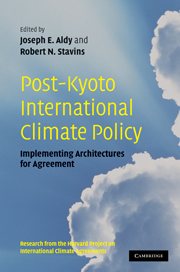Book contents
- Frontmatter
- Contents
- Harvard Environmental Economics Program, International Advisory Board
- Harvard Project on International Climate Agreements, Faculty Steering Committee
- Harvard Project on International Climate Agreements, Project Management
- List of figures
- List of tables
- List of contributors
- Foreword
- 1 Introduction
- Part I Alternative international policy architectures
- Part II Negotiation, assessment, and compliance
- 9 How to negotiate and update climate agreements
- 10 Metrics for evaluating policy commitments in a fragmented world: the challenges of equity and integrity
- 11 Justice and climate change: the unpersuasive case for per capita allocations of emissions rights
- 12 Toward a post-Kyoto climate change architecture: a political analysis
- Part III The role and means of technology transfer
- Part IV Global climate policy and international trade
- Part V Economic development, adaptation, and deforestation
- Part VI Modeling impacts of alternative allocations of responsibility
- Part VII Synthesis and conclusion
- Appendix A Selected List of Individuals Consulted, Harvard Project on International Climate Agreements
- Appendix B Workshops and Conferences, Harvard Project on International Climate Agreements
- Glossary and Abbreviations
- Index
9 - How to negotiate and update climate agreements
Published online by Cambridge University Press: 05 June 2012
- Frontmatter
- Contents
- Harvard Environmental Economics Program, International Advisory Board
- Harvard Project on International Climate Agreements, Faculty Steering Committee
- Harvard Project on International Climate Agreements, Project Management
- List of figures
- List of tables
- List of contributors
- Foreword
- 1 Introduction
- Part I Alternative international policy architectures
- Part II Negotiation, assessment, and compliance
- 9 How to negotiate and update climate agreements
- 10 Metrics for evaluating policy commitments in a fragmented world: the challenges of equity and integrity
- 11 Justice and climate change: the unpersuasive case for per capita allocations of emissions rights
- 12 Toward a post-Kyoto climate change architecture: a political analysis
- Part III The role and means of technology transfer
- Part IV Global climate policy and international trade
- Part V Economic development, adaptation, and deforestation
- Part VI Modeling impacts of alternative allocations of responsibility
- Part VII Synthesis and conclusion
- Appendix A Selected List of Individuals Consulted, Harvard Project on International Climate Agreements
- Appendix B Workshops and Conferences, Harvard Project on International Climate Agreements
- Glossary and Abbreviations
- Index
Summary
Executive summary
Climate change is a dynamic problem with uncertain consequences. As we learn more about the benefits and costs of abatements over time, any agreement made today is bound to be renegotiated and updated in the future. Anticipating such negotiations, every country may try to influence its future bargaining power to be able to negotiate a more favorable deal. Increasing the bargaining power can be done by (i) investing less than optimally in R&D, (ii) adapting more to climate change than what is socially optimal, (iii) signaling reluctance by delay, or (iv) delegating bargaining authority to representatives that are less in favor of an agreement. Such strategic behavior makes an efficient agreement less likely. In fact, the situation with an agreement can be worse than a situation without any agreement at all. Thus, it is immensely important to determine in advance the rules governing how the countries should negotiate and update future climate change agreements.
This chapter presents and discusses five such rules. First, the negotiations may be more efficient, and less strategic, if harmonization of contribution-levels is required across countries, or if the contribution-shares are pre-determined by some formula that itself is not subject to renegotiation. Second, the time horizon of an agreement should be long enough to prevent the above-mentioned strategies from being too influential. The larger the number of participants, the longer the time horizon should be. Third, the default (the outcome to which one reverts if the negotiations fail) should be the previous agreement or, even better, a very ambitious agreement. This provides an efficient starting point from which one may renegotiate the agreement.
- Type
- Chapter
- Information
- Post-Kyoto International Climate PolicyImplementing Architectures for Agreement, pp. 273 - 299Publisher: Cambridge University PressPrint publication year: 2009
- 2
- Cited by



